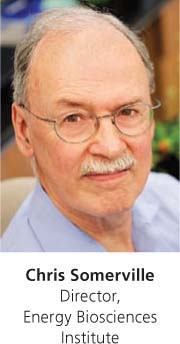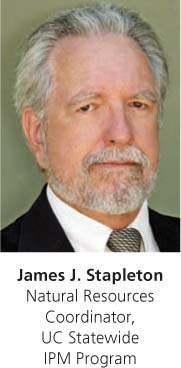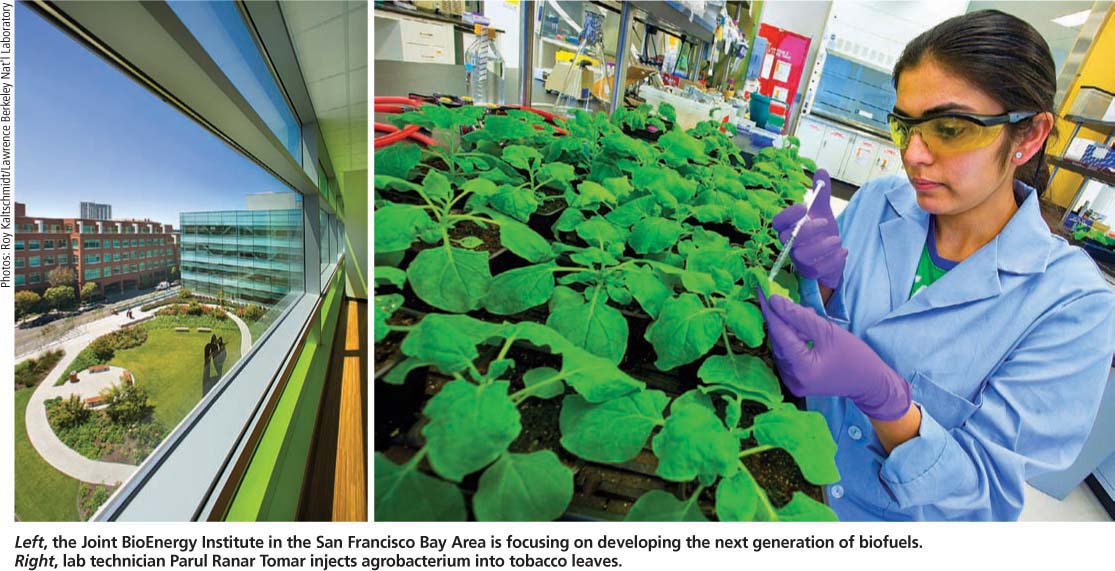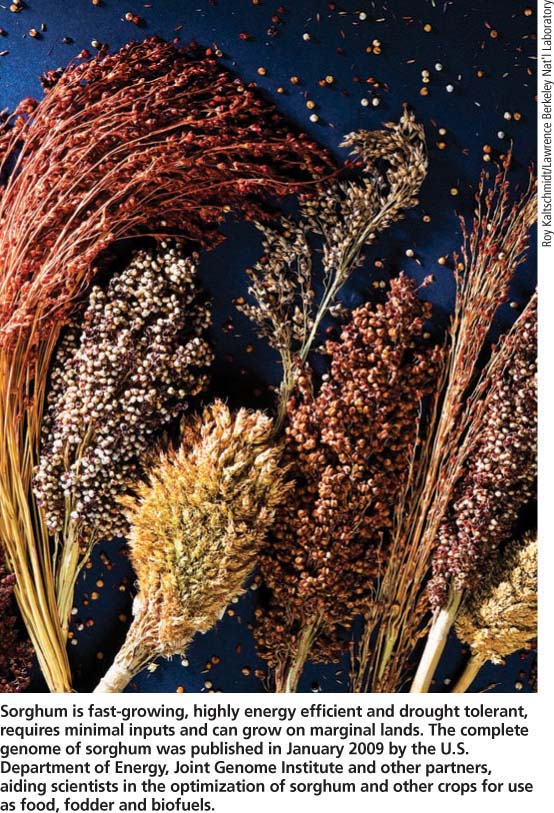All Issues
Biofuels: Growing toward sustainability
Publication Information
California Agriculture 63(4):155-158.
Published October 01, 2009
PDF | Citation | Permissions
Full text
Biofuels — fuels derived from plant materials and other kinds of biomass — have ridden a rollercoaster of public debate. When Hurricane Katrina wreaked havoc on U.S. energy supplies in 2005, biofuels came into prominence as a homegrown alternative to petroleum. As world oil prices continued to rise, former President Bush heralded biofuels as one cure for the U.S. addiction to oil.
In 2006, however, scientific debate erupted over unfavorable energy balances for ethanol made from corn. These concerns receded by 2007 after more thorough and systematic review suggested modest energy gains — as well as possible reductions in climate-altering greenhouse gases. But public favor was again short-lived. Increasing food prices during 2008, perceived to be partly the result of competition between grain and fuel markets, coupled with the suggestion that intensive production and indirect land-use changes negated greenhouse-gas benefits, reignited the debate and led some to declare biofuels “a crime against humanity.” Again, thorough and systematic analysis quieted the debate, but left large uncertainties regarding the future of biofuels. Meanwhile, investment dollars dried up as the world's economy contracted.
The complexity of issues surrounding biofuels and other types of bioenergy mirrors the structural complexity of the biomass resource that makes it valuable in myriad ways. Biomass serves multiple purposes — social, environmental, ecological, economic. Use of the resource to satisfy any significant fraction of our now vast and increasing appetite for energy will bring far-ranging consequences, and we have only recently begun to characterize standards and procedures that give us confidence to predict how such use can be sustainable. Many efforts are now under way to model global responses to different bioenergy policies and to optimize resource utilization. One of the primary, unknown quantities in global energy balance calculations is the burgeoning human population and concomitant increases in demand for energy, especially for transportation fuel. As we approach the potential carrying capacity of humans on the planet (California Agriculture, July-September 2006, page 106 ), with projected growth from almost 7 billion humans in 2008 to more than 9 billion by 2050, it remains to be seen how our energy system can be made sustainable.
The increased energy demand is exemplified by the development and production of inexpensive private autos (about $2,500) targeting consumers in developing nations, and the associated rise in numbers of vehicles on the road. Depending on economic conditions, several billion people who formerly depended on public or nonmotorized transportation will soon be able to purchase private vehicles. In India, prior to the present economic downturn, domestic car purchases nearly doubled from 2001 to 2006; while in China, private vehicle ownership has gone from 1 million to more than 40 million units in the past 17 years. The global demand for energy could soon reach staggering proportions.
Both the public and private sectors have recently made significant investments in research to make biomass conversion more economical and environmentally sustainable ( see page 162 ). The U.S. Department of Energy, British Petroleum, Chevron and others have made major grants to university and national laboratory consortia and institutes, such as the Bay Area-based Joint BioEnergy Institute (JBEI), the Energy Biosciences Institute (EBI) at UC Berkeley and the UC Davis Energy Institute, in an effort to advance bioenergy research and shorten the time to commercial deployment. Major expansion in national biofuel production is mandated by the federal Energy Independence and Security Act of 2007, under a Renewable Fuel Standard (RFS) enforcing reductions in greenhouse-gas emissions.
The complete poplar genome has been sequenced, allowing researchers to move forward in domesticating the tree for more-efficient biomass production.
Thanks
California Agriculture gratefully acknowledges the faculty co-chairs for this special collection on biofuels: UC Davis Energy Institute Director Bryan Jenkins and UC Integrated Pest Management Plant Pathologist James J. Stapleton.
California seeks to reduce the greenhouse-gas intensity of transportation fuels by implementing the Low Carbon Fuel Standard (LCFS), which may also encourage greater biofuel production. Yet there is little consensus regarding pathways forward to sustainably meet this demand. For example, inclusion of the indirect effects of land-use change continues to be a central component of the debates surrounding these policies ( see page 158 ).
Biomass applications.
It is important to remember that the production of liquid transportation biofuels is only one of the applications for biomass. Other uses such as electricity, heat, hydrogen and biobased chemicals and products also offer substantial promise and possible resource competition. Given these considerations, some investigators have recently argued that electricity, rather than liquid fuel, is more efficient and environmentally preferable for the future transportation market.
Biomass has been a major source of renewable electricity for California for the past three decades. However, for economic reasons, the resource has not competed effectively against wind and geothermal power in bidding into the state's resource-neutral Renewable Portfolio Standard (RPS). Increasing use of electricity for plug-in hybrid and battery-electric vehicles, and other electric transport options, will greatly expand the market for electricity from renewable resources, including biomass. A number of developing approaches for both large-scale fuel and electricity production are likely to prove commercially successful within the coming decade. Ensuring that these and other components of our energy system are sustainable will require careful design, implementation and enforcement. Scientists, industrialists and politicians must pay attention to regional and global impacts and interactions.
Environmental concerns.
Biofuel production, like any other industrial enterprise, has the potential to damage the environment, divert scarce water supplies, and lead to a number of other undesirable consequences. Indirect land-use change, which has been associated with some types of biofuel alternatives, may negatively influence atmospheric carbon balances. The use of food crops for some types of biofuels has also triggered concern about negative effects on food security for the world's urban poor. However, there is no scientific consensus on what constitutes sustainable bioenergy production practice, and not all feedstocks are equal in impact (see Science, July 17, 2009, Vol. 325, pages 270–1).
Public policy.
Changing public policies also introduce uncertainties. We need effective mechanisms to evaluate and act upon tradeoffs among competing social and environmental objectives. California's Bioenergy Action Plan is a case in point. Established to increase jobs and wealth within the state, the plan incorporated no specific measures of sustainability to guide industry development or regulation, and our ability to model global market responses to expanding use of land, water and other bioenergy resources remains limited at best. Adaptation of the plan to address sustainability issues should be considered. Life-cycle assessment should be a factor in determining policy support and welfare analysis may provide a more comprehensive methodology to gauge impacts ( see pages 191 and 199 ), but attention should also be given to what other fuel alternatives may emerge in the absence of substantial biofuel development. Sustainability applies to more than just biofuels and should be a guiding principle for all energy sectors.
Left, the Joint BioEnergy Institute in the San Francisco Bay Area is focusing on developing the next generation of biofuels. Right, lab technician Parul Ranar Tomar injects agrobacterium into tobacco leaves.
Biofuels in California.
This issue of California Agriculture focuses on the prospects for bioenergy, particularly the potentials and challenges for biofuels development. Californians could utilize abundant and diverse feedstocks that pose minimal competition with food production. The state currently produces a large amount of biomass as residues of agriculture and forestry, including forest management practices to reduce the threat and intensity of wildfire. Also, the urban sector produces increasing amounts of biogenic wastes, now deposited in landfills, which can serve as feedstocks for industrial energy recovery and biobased products manufacturing.
Moreover, dedicated energy-crop production could be expanded on marginal and degraded lands in the state, such as those on the west side of the San Joaquin Valley, where biomass production might help remediate salt-affected soils and drainage-impaired lands; or as a component of multicropping systems to aid in biological pest management (see California Agriculture, January-March 2009, page 41 ). Scientists have also advanced the conversion of biomass by biochemical and thermochemical means, and integrated heat, power and fuel production to optimize efficiency across a range of feedstocks and products ( see page 168 ).
Other investigators ( see page 185 ) have pursued plant and microbial research to improve the conversion of biomass to useful fuels and chemicals. Large energy and environmental benefits associated with the conversion of lignocellulosic materials, such as grass and wood, are limited by the inefficiency of current technology to convert complex polysaccharides into simple sugars for fermentation to ethanol and other products. Scientists are actively investigating how to better utilize other nonsugar components of cell walls. Research at JBEI and other labs seeks to develop improved enzymes for the more effective breakdown of lignocellulose and move them into yeasts and other organisms for industrial-scale processing ( see pages 178 ).
Cost concerns.
Biomass may be the only sustainable, large-scale resource for the production of compatible liquid fuels that can be readily integrated into our existing fuel infrastructure ( see page 185 ). On a pure heating value basis, biomass feedstocks could be worth about three times their current value in comparison to crude oil at a price of $65 per barrel. However, the cost of producing ethanol from lignocellulosic feedstocks needs to be reduced in competition with current starch-based ethanol production from corn. Consolidated processes that combine biomass deconstruction and fermentation steps offer increasing fuel yields and potential cost reductions. Large-scale demonstration projects now being funded by DOE and industry should offer insights into costs of full-scale deployment.
Sorghum is fast-growing, highly energy efficient and drought tolerant, requires minimal inputs and can grow on marginal lands. The complete genome of sorghum was published in January 2009 by the U.S. Department of Energy, Joint Genome Institute and other partners, aiding scientists in the optimization of sorghum and other crops for use as food, fodder and biofuels.
Sustainability.
Sustainability must be addressed at both regional and international levels for any large-scale bioenergy development ( see page 202 ). Governments have promoted the production of biofuels to address climate change, increase rural development and improve energy security, but are now questioning the wisdom of such policies with respect to the possible ramifications on food production and environmental quality. However, a framework that emphasizes resource-use efficiency can help identify sustainable approaches. Systems creating greater outputs for declining inputs generally constitute a move toward sustainability. In addition, public policy should distinguish among biofuels in terms of their impacts on carbon emissions, biodiversity, water and air pollution, and food availability.
The international Roundtable on Sustainable Biofuels and a number of other groups are currently in the process of defining international standards for sustainable production. The California Biomass Collaborative, a consortium of industry, government, academic, environmental and nongovernmental organizations, has recommended that performance-based sustainability standards guide future biomass development in the state. For the near-term, progress in larger scale development will require flexible, adaptive policies that also offer security for financial investment. The articles that follow assess the challenges and opportunities at hand, and offer recommendations for future policy, regulation, development and research.
Biofuel terms defined
Bioenergy is energy derived from biomass (living and recently living organisms). It is renewable energy if the biomass used is replenished by new growth.
Bioethanol or ethanol (C2H5OH) is an alcohol made by fermenting the component sugars in biomass. It can be used as a fuel for cars either in pure form, or blended with another fuel such as gasoline.
Biofuels are produced from biomass, including sugar- and starch-rich crops; oilseeds and other lipid sources such as certain types of algae; and lignocellulosic crops and residues such as grasses, woody plants, and plant or animal wastes. Biofuels can be liquids, gases or solids — alcohols or biodiesel, biogas, charcoal, and more.
Carbon intensity, as used in California's LCFS, is total direct and indirect greenhouse-gas (GHG) emissions per unit of energy produced in the full cycle of a transportation fuel. It is expressed in grams CO2-equivalent per Megajoule (g CO2e/MJ).
Energy balance is the total amount of energy used in a production process compared, on an equivalent basis, to the energy yielded in the resulting fuel.
Energy Independence and Security Act (EISA) of 2007 requires, among other things, that the annual total amount of biofuels in the United States increases to 36 billion gallons by 2022, from 4.7 billion gallons in 2007.
Indirect land-use change (iLUC), although part of California's LCFS regulation, is subject to debate. “Land-use change” by itself can be more or less beneficial, but may also result in release of carbon originally stored in the soil or as standing biomass, increasing GHG in the atmosphere, and reducing the overall GHG savings over a biofuel's life cycle. An iLUC occurs when a change in one location also induces a change in land use elsewhere, such as an increase in U.S. corn production for ethanol inducing rainforest conversion to agriculture elsewhere in the world.
Life-cycle analysis (LCA) is the assessment of environmental impacts of a given product or service over its full lifetime. This includes impacts of raw material production, manufacture, distribution, use and disposal. The extent to which an LCA includes iLUC and other effects depends on where the system boundary is drawn.
Lignocellulose is the structural component of biomass that makes up much of the tough, “recalcitrant” cell walls of plants, and poses technical hurdles for some second-generation, or cellulosic biofuels. It is composed of variable amounts of complex sugars (cellulose and hemi-cellulose) tightly bound to lignin.
Low Carbon Fuel Standard (LCFS), ordered by Governor Schwarzenegger in January 2007, calls for at least a 10% reduction in the carbon intensity of California's transportation fuels by 2020, relative to a 2010 baseline. The California Air Resources Board (CARB) approved adoption of LCFS regulations in April, including use of iLUC effects in computing carbon intensity for certain types of biofuels.
Pyrolysis is decomposition by heat to produce gases, liquids and char (solid residue); all can be used as fuels, or utilized as feedstocks for chemical or material industries.
Renewable energy is generated from natural resources (sunlight, wind, tides, biomass and others) and replenished in a sustainable cycle of use and replacement.
Renewable Fuel Standard (RFS), under the EISA, mandates renewable fuel production volumes over time in the United States for various classes of biofuels and enforces reductions in GHG emissions by fuel type.
Renewable Portfolio Standard (RPS), enacted in California in 2002 and accelerated in 2006, requires electricity corporations to expand their renewable energy portfolios by 1% each year until reaching 20% in 2010. Governor Schwarzenegger also ordered the state's electricity providers to supply 33% of their electricity from renewable sources by 2020, and recently charged the CARB with adopting a regulation by July 31, 2010, to achieve that goal.
Thermochemical processing is the conversion of biomass by the action of both heat and chemical reaction, and includes pyrolysis, gasification and combustion.










